Building Excellence | Library by Design, Spring 2016
The Biennial AIA/ALA Library Building Awards honor new and renovated libraries that reflect their communities
By Cesar R. Bustamante Jr.
This year, seven libraries received the prestigious 2016 AIA/ALA Library Building Award, which recognizes excellence in architectural library design. The award recipients, chosen by the American Institute of Architects (AIA) and the American Library Association (ALA), exemplify how the traditional role of libraries has evolved. The designs of these community spaces differ to reflect the needs of the surrounding residents, which vary according to neighborhood or campus.

Billings Public Library | MT will bruder+PARTNERS ltd with O2 Architects
With an anonymous donor funding the design cost for the only public library in Montana’s largest metropolitan area, the architects were charged with crafting a structure that would be iconic and bring the community pride.
Billings Public Library from the inside is made to feel much like a community member’s own living room. It is a functional box shape, with stainless steel shading panels to provide optimal lighting for library activities and to maximize the views, which include the distinct geological structure of Montana’s Rim Rocks.
The community’s commitment to sustainability is also reflected in the use of local and reused material. Its state-of-the-art cooling, heating, and plumbing systems have earned it a Leadership in Energy & Environmental Design (LEED) Platinum certification. (Photo by Bill Timmerman)
 Chicago Public Library, Chinatown Branch Chicago Skidmore, Owings & Merrill LLP
Chicago Public Library, Chinatown Branch Chicago Skidmore, Owings & Merrill LLP
Designing a library so that the historic South Chinatown meets the burgeoning North Chinatown made for a great opportunity to craft a unique place that would be a prime destination. Wight & Company was the lead team on the project, selected by the Chicago's Public Building Commission.
The two-story Chicago Public Library branch’s pebble-shaped, three-sided design is inspired by feng shui philosophy. It allows for fluid pedestrian movement, landscaping throughout the site, and a view of the building from all sides.
A rooftop oculus offers natural light buildingwide, while the two-way transparency of the glass exterior lets passersby see library activity within the facility. The second floor has a mixed-media mural created with the input of community members, representing the past, present, and future of Chinatown. (Photo ©Jon Miller/Hedrich Blessing)
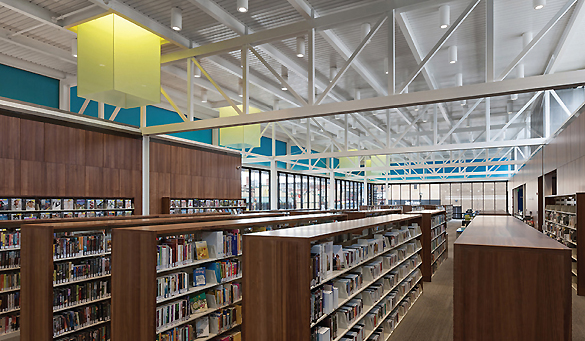
Hennepin County Walker Library | Minneapolis VJAA
Despite the challenge of a diminished budget after the recession, the library’s architects were able to create a structure that is identifiable with the diverse community and its arts-oriented neighborhood.
A one-story building with a two-story presence, its stainless steel and glass facade reflects the image of the neighborhood back to itself. Also, because the area sees heavy traffic, the building is angled to aid in the flow of pedestrians and bicyclists.
Sound-insulated glass helps the library become a quiet but still open space in which to read and think in the busy area. Nine rooftop light monitors track the sun, changing the light’s intensity and shifting their color depending on the time of day to give patrons an animated experience of time passing. (Photo ©Paul Crosby)
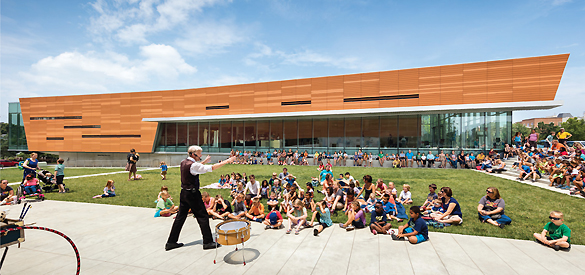
Lawrence Public Library | KS Gould Evans
Energy performance was a priority for the architects from the very beginning of this renovation and expansion project. They found that by “wrapping” the original facilities with an additional layer of reading rooms and service spaces, they could achieve that economy of operation while expanding the library.
The architects were able to reduce energy consumption by allowing more daylight into the library and providing an unbroken insulation system. Ultimately, the library obtained LEED Silver certification (and was named a 2015 LJ New Landmark Library). Additionally, a plaza park is connected to the library, offering a stepped amphitheater and reading garden and supporting a seasonal skating rink. (Photo ©Tim Griffith)
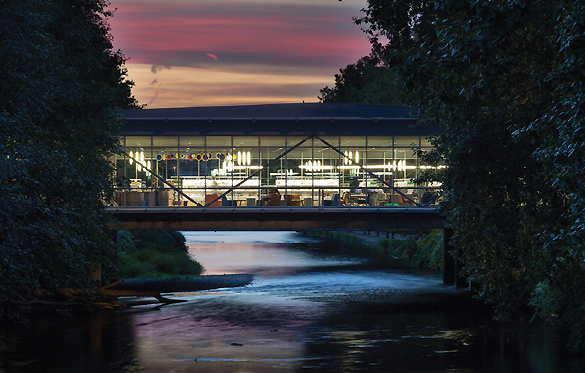
Renton Public Library | WA The Miller Hull Partnership
Hanging over the Washington State Cedar River and a salmon habitat, the beloved Renton Public Library posed a particular challenge with regard to renovation. The goal was not to harm the environment while updating the library to handle Washington’s current seismic activity.
Through creative solutions such as using landward piling, the architects were able to do just that and add additional changes that further enhance the library’s bridge-like features.
Renton Public Library’s current design celebrates the city’s industrial heritage in its use of cross bracing and aluminum. It also gives its users a better view of the iconic river by extending the glass windows from floor to ceiling. (Photo ©Lara Swimmer)
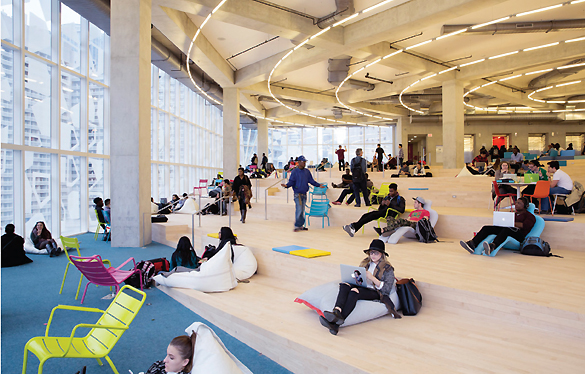
Student Learning Centre, Ryerson University | Toronto Snøhetta and Zeidler Partnership Architects
As an urban commuter college, Ryerson University wanted a library to serve as a learning hub. It needed to be a place that was comfortable, relaxing, and acentral gathering location.
To that end, the Ryerson University Student Learning Centre has eight distinct floors, each design inspired by nature. “The Garden” floor, for example, hosts quiet areas and classrooms, while “The Beach” is a study area with a series of terraces.
The iconic identity of each floor is meant to stimulate creativity and be open for critical interpretation by patrons on how best to use the space. Students have already worked on numerous activities, including a fashion show and break dancing inside. (Photo ©Lorne Bridgman)
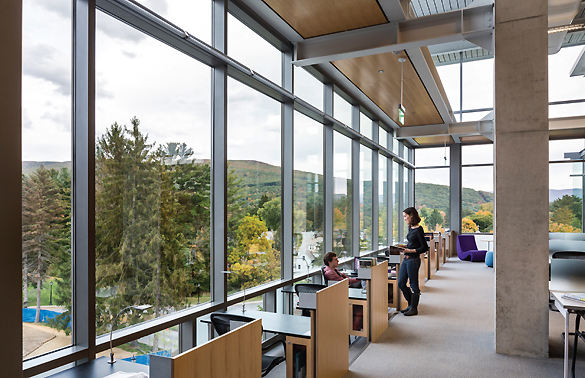
Sawyer Library, Williamstown | MA Bohlin Cywinski Jackson
Realizing that it would be more cost-effective to build a new library rather than restore the old one, the Sawyer Library was constructed as a 21st-century facility that respected the past library’s heritage.
Marrying the old and the new, the updated Sawyer Library repurposed architecture from the historic library building into its design, offering a varied experience for solitary study depending on where you are in the space.
Also, relocating the library to the former faculty housing made it a social destination that gives patrons sweeping views of the green space and a glass facade that fills the library with light. (Photo ©Peter Aaron/Otto)
RELATED
ALREADY A SUBSCRIBER? LOG IN
We are currently offering this content for free. Sign up now to activate your personal profile, where you can save articles for future viewing









Add Comment :-
Comment Policy:
Comment should not be empty !!!
Alfredo A Gonzales
Helo LJ,I am amazed by American libraries, they are modern, state of the art and very useful. I want to traslate and publish in Peru this 2016 articles on awarded libraries. The source will be mentioned and eulogiated, in the cause of trying to improve Peruvian libraries, usually a disaster. Thanks.Posted : Nov 20, 2019 04:13